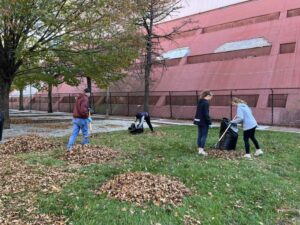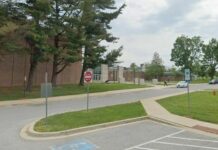Baltimore City Community College recently approved a contract to demolish its Bard Building on August 2 — a move that may prove beneficial to the nearby Holocaust Memorial, which stands directly next door to the building.

Named for former college president Dr. Harry Bard, the building — which stands at five stories tall and used to house classrooms, offices and a library — has been abandoned since it closed in 2009.
There were plans to redevelop the site in 2012, but they fell through due to concerns that the Holocaust Memorial would have to be moved. While the Holocaust Memorial was able to keep its location, a new problem emerged: The vacant state of the Bard Building deterred visitors. The building was prone to vandalism and break-ins, and staff at the Baltimore Jewish Council worried that its state of disrepair discouraged people who had come to pay their respects.
“It’s a little intimidating and discouraging to see this fenced-off building right next to the memorial,” BJC Executive Director Howard Libit said. “I don’t think it’s a particularly welcoming part of that parcel [of land].”
He added that, despite this, the Baltimore Jewish Council takes responsibility for the memorial’s upkeep and regularly pays for cleanup and snow and pest removal services around the area.
The website of artist Joseph Sheppard, who created the sculpture that stands at the memorial to this day, recounts the memorial’s history, which dates back to 1976. Alvin Fisher, a Hebrew teacher at Temple Oheb Shalom, became concerned over Holocaust denial in his ninth grade class. Fisher became motivated to get a Holocaust memorial constructed in Baltimore after this experience.
The website adds that the memorial was initially constructed in 1980 and later redesigned and rededicated in 1997.
BCCC owns the land the memorial sits on, and the ultimate fate of the Bard Building’s land and how it will affect the Holocaust Memorial is something that the college and the BJC have been heavily involved in.
Plans for what to do with the land the building sits on have been gestating since its closing. In addition to 2012’s redevelopment efforts, 2017 saw Power Plant Live! lead developer David Cordish planning to convert it into residential and retail space, but that plan was rejected by BCCC in 2021. Also in 2021, then-Gov. Larry Hogan set aside $7.4 million of state funding to convert the building’s property into a parking lot, but this plan was met with opposition from Maryland Senate President Bill Ferguson and members of the BCCC community.
Now, plans are moving forward to convert the land into green space. Libit and the rest of the Baltimore Jewish Council have been working with Maryland’s Department of General Services to ensure that the Holocaust Memorial is protected during the Bard Building’s demolition.
“We wanted to be helpful to them in terms of making the demolition go smoothly,” Libit said. “We’ve worked with the demolition contractor to take the necessary steps to protect the memorial, so we want to accommodate their work. I’m sure it’s not easy to take down a building on Lombard Street.”
An approved item from an Aug. 2 Board of General Services meeting clarified that the contracting company hired by the board for the demolition will be responsible for protecting the area while they demolish the Bard Building, as well as the restoration of nearby sidewalks and the addition of lighting.
BCCC has noted that the new green space will be temporary while the college determines what to use the property for, but Libit believes that the green space will make the Holocaust Memorial more appealing to visitors.
“Downtown does not have a lot of green space, so having it there will probably attract people who want to come through and take walks, eat lunch outside, things like that,” he said. “I think more people may take a moment to stop there while they are exploring downtown.”
People will still be able to visit the Holocaust Memorial while the demolition is underway. Nick Cavey, the director of public information at the Maryland Department of General Services, noted that while some nearby streets and sidewalks will be impacted by construction, “no vertical monuments will experience restricted access.”
“We’re certainly grateful that Senate President Ferguson and the state put together the money to demolish the building,” Libit said. “We look forward to seeing this project unfold.”







